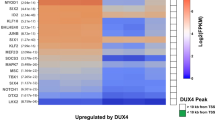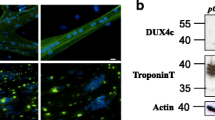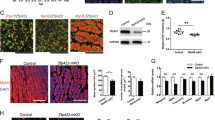Abstract
Homeobox genes encode transcription factors that regulate embryonic development programs including organogenesis, axis formation and limb development. Previously, we identified and cloned a mouse double homeobox gene, Duxbl, whose homeodomain exhibits the highest identity (67 %) to human DUX4, a candidate gene of facioscapulohumeral muscular dystrophy (FSHD). Duxbl proteins have been shown to be expressed in elongated myocytes and myotubes of trunk and limb muscles during embryogenesis. In this study, we found that Duxbl maintained low expression levels in various adult muscles. Duxbl proteins were induced to express in activated satellite cells and colocalized with MyoG, a myogenic differentiating marker. Furthermore, Duxbl proteins were not detected in quiescent satellite cells but detected in regenerated myocytes and colocalized with MyoD and MyoG following cardiotoxin-induced muscle injury. Ectopic Duxbl overexpressions in C2C12 myoblast cells promoted cell proliferation through mainly enhancing cyclin D1 and hyper-phosphorylated retinoblastoma protein but reducing p21 expression. However, Duxbl overexpression in C2C12 cells inhibited myogenic differentiation by decreasing MyoD downstream gene expressions, including M-cadherin, MyoG, p21 and cyclin D3 but not MyoD itself. Duxbl overexpressions also promoted cell proliferation but blocked MyoD-induced myogenic conversion in multipotent mesenchymal C3H10T1/2 cells. In addition, results of a luciferase reporter assay suggest that Duxbl negatively regulated MyoG promoter activity through the proximal two E boxes. In conclusion, these results indicate that Duxbl may play a crucial role in myogenesis and postnatal muscle regeneration by activating and proliferating satellite and myoblast cells.








Similar content being viewed by others
References
Andrés V, Walsh K (1996) Myogenin expression, cell cycle withdrawal, and phenotypic differentiation are temporally separable events that precede cell fusion upon myogenesis. J Cell Biol 132:657–666
Ansseau E, Laoudj-Chenivesse D, Marcowycz A, Tassin A, Vanderplanck C, Sauvage S, Barro M, Mahieu I, Leroy A, Mainfroid V (2009) DUX4c is up-regulated in FSHD. It induces the MYF5 protein and human myoblast proliferation. PLoS ONE 4:e7482
Aurade F, Pinset C, Chafey P, Gros F, Montarras D (1994) Myf5, MyoD, myogenin and MRF4 myogenic derivatives of the embryonic mesenchymal cell line C3H10T1/2 exhibit the same adult muscle phenotype. Differentiation 55:185–192
Black BL, Olson EN (1998) Transcriptional control of muscle development by myocyte enhancer factor-2 (MEF2) proteins. Annu Rev Cell Dev Biol 14:167–196
Blais A, Tsikitis M, Acosta-Alvear D, Sharan R, Kluger Y, Dynlacht BD (2005) An initial blueprint for myogenic differentiation. Genes Dev 19:553
Boncinelli E (1997) Homeobox genes and disease. Curr Opin Genet Dev 7:331–337
Bosnakovski D, Lamb S, Simsek T, Xu Z, Belayew A, Perlingeiro R, Kyba M (2008a) DUX4c, an FSHD candidate gene, interferes with myogenic regulators and abolishes myoblast differentiation. Exp Neurol 214:87–96
Bosnakovski D, Xu Z, Gang EJ, Galindo CL, Liu M, Simsek T, Garner HR, Agha-Mohammadi S, Tassin A, Coppée F (2008b) An isogenetic myoblast expression screen identifies DUX4-mediated FSHD-associated molecular pathologies. EMBO J 27:2766–2779
Cenciarelli C, De Santa F, Puri PL, Mattei E, Ricci L, Bucci F, Felsani A, Caruso M (1999) Critical role played by cyclin D3 in the MyoD-mediated arrest of cell cycle during myoblast differentiation. Mol Cell Biol 19:5203
Cillo C, Cantile M, Faiella A, Boncinelli E (2001) Homeobox genes in normal and malignant cells. J Cell Physiol 188:161–169
Collins CA, Gnocchi VF, White RB, Boldrin L, Perez-Ruiz A, Relaix F, Morgan JE, Zammit PS (2009) Integrated functions of Pax3 and Pax7 in the regulation of proliferation, cell size and myogenic differentiation. PLoS ONE 4:e4475
Danoviz ME, Yablonka-Reuveni Z (2012) Skeletal muscle satellite cells: background and methods for isolation and analysis in a primary culture system. Methods Mol Biol 798:21–52
Davis RL, Weintraub H, Lassar AB (1987) Expression of a single transfected cDNA converts fibroblasts to myoblasts. Cell 51:987–1000
Dixit M, Ansseau E, Tassin A, Winokur S, Shi R, Qian H, Sauvage S, Mattéotti C, Van Acker AM, Leo O (2007) DUX4, a candidate gene of facioscapulohumeral muscular dystrophy, encodes a transcriptional activator of PITX1. Proc Natl Acad Sci U S A 104:18157–18162
Dodou E, Xu SM, Black BL (2003) mef2c is activated directly by myogenic basic helix-loop-helix proteins during skeletal muscle development in vivo. Mech Dev 120:1021–1032
Ezhevsky SA, Ho A, Becker-Hapak M, Davis PK, Dowdy SF (2001) Differential regulation of retinoblastoma tumor suppressor protein by G(1) cyclin-dependent kinase complexes in vivo. Mol Cell Biol 21:4773–4784
Flemington EK, Speck SH, Kaelin WG (1993) E2F-1-mediated transactivation is inhibited by complex formation with the retinoblastoma susceptibility gene product. Proc Natl Acad Sci U S A 90:6914–6918
Galliot B, de Vargas C, Miller D (1999) Evolution of homeobox genes: Q50 Paired-like genes founded the Paired class. Dev Genes Evol 209:186–197
Gehring WJ (1987) Homeo boxes in the study of development. Science 236:1245–1252
Gehring WJ, Qian YQ, Billeter M, Furukubo-Tokunaga K, Schier AF, Resendez-Perez D, Affolter M, Otting G, Wuthrich K (1994) Homeodomain-DNA recognition. Cell 78:211–223
Grounds MD, Yablonka-Reuveni Z (1993) Molecular and cell biology of skeletal muscle regeneration. Mol Cell Biol Hum Dis Ser 3:210–256
Guo K, Walsh K (1997) Inhibition of myogenesis by multiple cyclin-Cdk complexes. Coordinate regulation of myogenesis and cell cycle activity at the level of E2F. J Biol Chem 272:791–797
Guo K, Wang J, Andres V, Smith RC, Walsh K (1995) MyoD-induced expression of p21 inhibits cyclin-dependent kinase activity upon myocyte terminal differentiation. Mol Cell Biol 15:3823–3829
Halevy O, Novitch BG, Spicer DB, Skapek SX, Rhee J, Hannon GJ, Beach D, Lassar AB (1995) Correlation of terminal cell cycle arrest of skeletal muscle with induction of p21 by MyoD. Science 267:1018–1021
Hasty P, Bradley A, Morris JH, Edmondson DG, Venuti JM, Olson EN, Klein WH (1993) Muscle deficiency and neonatal death in mice with a targeted mutation in the myogenin gene. Nature 364:501–506
Hawke TJ, Garry DJ (2001) Myogenic satellite cells: physiology to molecular biology. J Appl Physiol 91:534–551
Hawke TJ, Meeson AP, Jiang N, Graham S, Hutcheson K, DiMaio JM, Garry DJ (2003) p21 is essential for normal myogenic progenitor cell function in regenerating skeletal muscle. Am J Physiol Cell Physiol 285:C1019–C1027
Helin K (1993) The retinoblastoma protein as a transcriptional repressor. Trends Cell Biol 3:43–46
Holland PW, Takahashi T (2005) The evolution of homeobox genes: implications for the study of brain development. Brain Res Bull 66:484–490
Huang SL, Chou TC, Lin TH, Tsai MS, Wang SH (2013) Gcse, a novel germ-cell-specific gene, is differentially expressed during meiosis and gametogenesis. Reprod Sci 20:1193–1206
Ishibashi J, Perry RL, Asakura A, Rudnicki MA (2005) MyoD induces myogenic differentiation through cooperation of its NH2- and COOH-terminal regions. J Cell Biol 171:471–482
Kassar-Duchossoy L, Gayraud-Morel B, Gomès D, Rocancourt D, Buckingham M, Shinin V, Tajbakhsh S (2004) Mrf4 determines skeletal muscle identity in Myf5: Myod double-mutant mice. Nature 431:466–471
Kawazu M, Yamamoto G, Yoshimi M, Yamamoto K, Asai T, Ichikawa M, Seo S, Nakagawa M, Chiba S, Kurokawa M, Ogawa S (2007) Expression profiling of immature thymocytes revealed a novel homeobox gene that regulates double-negative thymocyte development. J Immunol 179:5335–5345
Kitzmann M, Fernandez A (2001) Crosstalk between cell cycle regulators and the myogenic factor MyoD in skeletal myoblasts. Cell Mol Life Sci 58:571–579
Kowaljow V, Marcowycz A, Ansseau E, Conde CB, Sauvage S, Mattéotti C, Arias C, Corona ED, Nuñez NG, Leo O (2007) The DUX4 gene at the FSHD1A locus encodes a pro-apoptotic protein. Neuromuscul Disord 17:611–623
LaBaer J, Garrett MD, Stevenson LF, Slingerland JM, Sandhu C, Chou HS, Fattaey A, Harlow E (1997) New functional activities for the p21 family of CDK inhibitors. Genes Dev 11:847–862
Launay T, Armand AS, Charbonnier F, Mira JC, Donsez E, Gallien CL, Chanoine C (2001) Expression and neural control of myogenic regulatory factor genes during regeneration of mouse soleus. J Histochem Cytochem 49:887–899
Leidenroth A, Hewitt J (2010) A family history of DUX4: phylogenetic analysis of DUXA, B, C and Duxbl reveals the ancestral DUX gene. BMC Evol Biol 10:364
Lemmers RJ, van der Vliet PJ, Klooster R, Sacconi S, Camano P, Dauwerse JG, Snider L, Straasheijm KR, van Ommen GJ, Padberg GW, Miller DG, Tapscott SJ, Tawil R, Frants RR, van der Maarel SM (2010) A unifying genetic model for facioscapulohumeral muscular dystrophy. Science 329:1650–1653
Li H, Tsai MS, Chen CY, Lian WC, Chiu YT, Chen GD, Wang SH (2006) A novel maternally transcribed homeobox gene, Eso-1, is preferentially expressed in oocytes and regulated by cytoplasmic polyadenylation. Mol Reprod Dev 73:825–833
Magenta A, Cenciarelli C, De Santa F, Fuschi P, Martelli F, Caruso M, Felsani A (2003) MyoD stimulates RB promoter activity via the CREB/p300 nuclear transduction pathway. Mol Cell Biol 23:2893–2906
Mansouri A (1998) The role of Pax3 and Pax7 in development and cancer. Crit Rev Oncog 9:141–149
Mansouri A, Goudreau G, Gruss P (1999) Pax genes and their role in organogenesis. Cancer Res 59:1707s–1709s, discussion 1709s-1710s
Martelli F, Cenciarelli C, Santarelli G, Polikar B, Felsani A, Caruso M (1994) MyoD induces retinoblastoma gene expression during myogenic differentiation. Oncogene 9:3579–3590
Nabeshima Y, Hanaoka K, Hayasaka M, Esumi E, Li S, Nonaka I (1993) Myogenin gene disruption results in perinatal lethality because of severe muscle defect. Nature 364:532–535
Olguin HC, Yang Z, Tapscott SJ, Olwin BB (2007) Reciprocal inhibition between Pax7 and muscle regulatory factors modulates myogenic cell fate determination. J Cell Biol 177:769–779
Parker M, Deane N, Thompson E, Whitehead R, Mithani S, Washington M, Datta P, Dixon D, Beauchamp R (2003) Over-expression of cyclin D1 regulates Cdk4 protein synthesis. Cell prolif 36:347–360
Plasilova M, Schonmeyr B, Fernandez J, Clavin N, Soares M, Mehrara BJ (2009) Accelerating stem cell proliferation by down-regulation of cell cycle regulator p21. Plast Reconstr Surg 123:149S–157S
Rao SS, Kohtz DS (1995) Positive and negative regulation of D-type cyclin expression in skeletal myoblasts by basic fibroblast growth factor and transforming growth factor beta. A role for cyclin D1 in control of myoblast differentiation. J Biol Chem 270:4093–4100
Rao SS, Chu C, Kohtz DS (1994) Ectopic expression of cyclin D1 prevents activation of gene transcription by myogenic basic helix-loop-helix regulators. Mol Cell Biol 14:5259–5267
Rhodes SJ, Konieczny SF (1989) Identification of MRF4: a new member of the muscle regulatory factor gene family. Genes Dev 3:2050–2061
Richards M, Coppee F, Thomas N, Belayew A, Upadhyaya M (2012) Facioscapulohumeral muscular dystrophy (FSHD): an enigma unravelled? Hum Genet 131:325–340
Rudnicki MA, Schnegelsberg PN, Stead RH, Braun T, Arnold HH, Jaenisch R (1993) MyoD or Myf-5 is required for the formation of skeletal muscle. Cell 75:1351–1359
Sharma V, Harafuji N, Belayew A, Chen YW (2013) DUX4 differentially regulates transcriptomes of human rhabdomyosarcoma and mouse C2C12 cells. PLoS ONE 8:e64691
Skapek SX, Rhee J, Spicer DB, Lassar AB (1995) Inhibition of myogenic differentiation in proliferating myoblasts by cyclin D1-dependent kinase. Science 267:1022–1024
Snider L, Geng LN, Lemmers RJLF, Kyba M, Ware CB, Nelson AM, Tawil R, Filippova GN, van der Maarel SM, Tapscott SJ (2010) Facioscapulohumeral dystrophy: incomplete suppression of a retrotransposed gene. PLoS Genet 6:e1001181
Tapscott SJ (2005) The circuitry of a master switch: Myod and the regulation of skeletal muscle gene transcription. Development 132:2685–2695
Tassin A, Laoudj-Chenivesse D, Vanderplanck C, Barro M, Charron S, Ansseau E, Chen YW, Mercier J, Coppee F, Belayew A (2013) DUX4 expression in FSHD muscle cells: how could such a rare protein cause a myopathy? J Cell Mol Med 17:76–89
Tsumagari K, Chang SC, Lacey M, Baribault C, Chittur SV, Sowden J, Tawil R, Crawford GE, Ehrlich M (2011) Gene expression during normal and FSHD myogenesis. BMC Med Genom 4:67
van Deutekom JCT, Wljmenga C, Tlenhoven EAEV, Gruter AM, Hewitt JE, Padberg GW, Ommen GJB, Hofker MH, Fronts RR (1993) FSHD associated DNA rearrangements are due to deletions of integral copies of a 3.2 kb tandemly repeated unit. Hum Mol Genet 2:2037–2042
Wallace LM, Garwick SE, Mei W, Belayew A, Coppee F, Ladner KJ, Guttridge D, Yang J, Harper SQ (2010) DUX4, a candidate gene for facioscapulohumeral muscular dystrophy, causes p53-dependent myopathy in vivo. Ann Neurol 63:540–552
Wijmenga C, Hewitt JE, Sandkuijl LA, Clark LN, Wright TJ, Dauwerse HG, Gruter AM, Hofker MH, Moerer P, Williamson R (1992) Chromosome 4q DNA rearrangements associated with facioscapulohumeral muscular dystrophy. Nat Genet 2:26–30
Wu SL, Tsai MS, Wong SH, Hsieh‐Li HM, Tsai TS, Chang WT, Huang SL, Chiu CC, Wang SH (2010) Characterization of genomic structures and expression profiles of three tandem repeats of a mouse double homeobox gene: Duxbl. Dev Dyn 239:927–940
Zammit PS, Golding JP, Nagata Y, Hudon V, Partridge TA, Beauchamp JR (2004) Muscle satellite cells adopt divergent fates: a mechanism for self-renewal? J Cell Biol 166:347–357
Zammit PS, Partridge TA, Yablonka-Reuveni Z (2006a) The skeletal muscle satellite cell: the stem cell that came in from the cold. J Histochem Cytochem 54:1177–1191
Zammit PS, Relaix F, Nagata Y, Ruiz AP, Collins CA, Partridge TA, Beauchamp JR (2006b) Pax7 and myogenic progression in skeletal muscle satellite cells. J Cell Sci 119:1824–1832
Zhang W, Behringer RR, Olson EN (1995) Inactivation of the myogenic bHLH gene MRF4 results in up-regulation of myogenin and rib anomalies. Genes Dev 9:1388–1399
Acknowledgments
This work was supported by grants from the National Science Council (NSC) of Taiwan with grant numbers NSC97-2320-B-040-010-MY3 and NSC100-2320-B-040-012; Chung Shan Medical University with grant number CSMU-INT-101-18 and Chang-Hua Christian Hospital with grant number 102-CCH-IRP-036.
Conflict of interest
The authors declare no conflict of interests. Confocal microscope, which is supported by the National Science Council, Ministry of Education and Chung Shan Medical University, was performed in the instrument Center of Chung Shan Medical University.
Author information
Authors and Affiliations
Corresponding author
Additional information
Shey-Lin Wu, Guo-Zili Li and Chin-Yi Chou contributed equally in this work
This work was supported by grants from the National Science Council of Taiwan (NSC97-2320-B-040-010-MY3, NSC100-2320-B-040-012), Chung Shan Medical University (CSMU-INT-101-18) and Chang-Hua Christian Hospital (102-CCH-IRP-036).
Electronic supplementary material
Below is the link to the electronic supplementary material.
Electronic Supplementary Material Table S1
Primers used in the RT-PCR and real-time PCR (DOC 44 kb)
Electronic Supplementary Material Fig. S1
Expression profiles of Duxbl and MRFs following cardiotoxin injection. a Total RNAs were extracted from TA muscles of indicated days following cardiotoxin injection and then RT-PCRs were performed for detecting MyoD, MyoG and Duxbl expressions. α-tubulin was used as internal controls. Reactions without RNA (-) were used as negative controls; reactions with plasmids containing each cDNA were used as positive controls (C). b–e Expressions and co-localizations of Duxbl (d) and MyoG (c) proteins in regenerating muscles. Transverse sections of regenerating TA muscles taken from cardiotoxin treated adult mouse were immunostained with MyoG (c, green) or Duxbl (d, red) antibodies, then merged (e, yellow), and counter-stained with DAPI (b, blue). Duxbl signals were colocalized with MyoG in satellite cells as stars (*) indicated. Scale bars 20 μm (GIF 179 kb)
Electronic Supplementary Material Fig. S2
Duxbl overexpressions promote C2C12, Sol8 and 10T1/2 cell proliferations. a Growth curves of vector only (vector) and Duxbl overexpression vector (Duxbl) transfected C2C12 cells were determined by counting cell numbers at different time points. b Duxbl overexpressions promote Sol8 cell proliferations by MTT assay. Cell survival assays were performed after transfected with empty vector (vector) or Duxbl expression vector (Duxbl) for 0, 24 and 48 h. c Growth curves of vector only (Vector) and Duxbl overexpression vector (Duxbl) transfected 10T1/2 cells were determined by counting cell numbers. d, e Proliferations of vector only (d, Vector) and Duxbl overexpression vector (e, Duxbl) transfected C2C12 cells were evaluated by BrdU labeling and detection kit I (Roche). Representative images of cells were taken by fluorescence microscope. The percentages of BrdU positive cells were measured and calculated (f). P < 0.05(*); P < 0.001(***) (GIF 48 kb)
Electronic Supplementary Material Fig. S3
Quantifications of mRNA and protein levels of MRFs and cell cycle regulators based on results of Fig. 4. Expression fold changes of cell cycle regulators (a) and MRFs (b, b’) in Duxbl overexpression vector (Duxbl) relative to vector only (Vector) transfected C2C12 cells were shown, respectively. P < 0.05(*); P < 0.001(***) (GIF 34 kb)
Electronic Supplementary Material Fig. S4
Quantifications of mRNA and protein levels of MRFs, differentiating factors, and cell cycle regulators based on Fig. 6. Expression fold changes of mRNAs (a) or proteins (b) in Duxbl overexpression vector (Duxbl) relative to vector only (Vector) transfected C2C12 cells were shown. P < 0.05(*); P < 0.01(**); P < 0.001(***) (GIF 44 kb)
Rights and permissions
About this article
Cite this article
Wu, SL., Li, GZ., Chou, CY. et al. Double homeobox gene, Duxbl, promotes myoblast proliferation and abolishes myoblast differentiation by blocking MyoD transactivation. Cell Tissue Res 358, 551–566 (2014). https://doi.org/10.1007/s00441-014-1974-x
Received:
Accepted:
Published:
Issue Date:
DOI: https://doi.org/10.1007/s00441-014-1974-x




